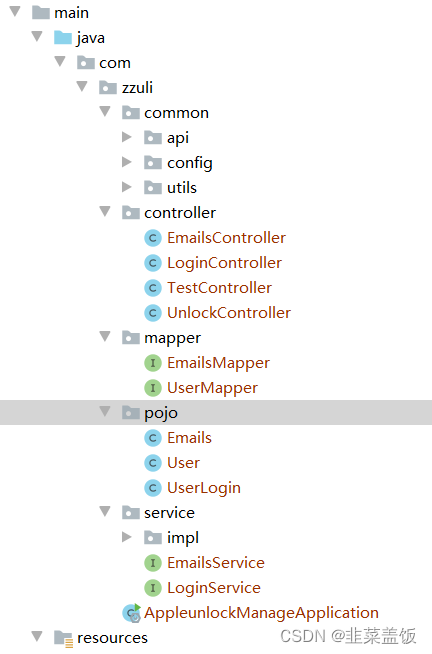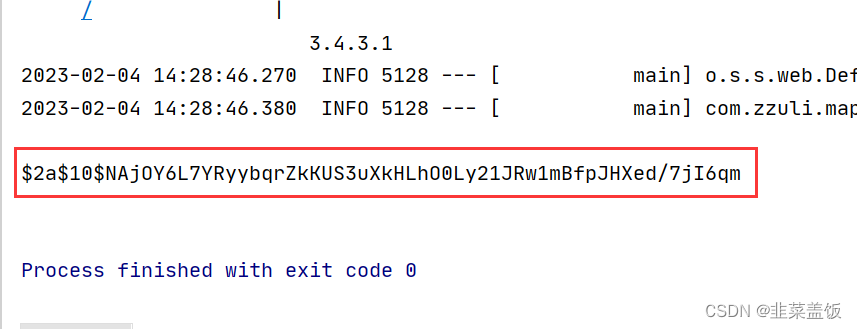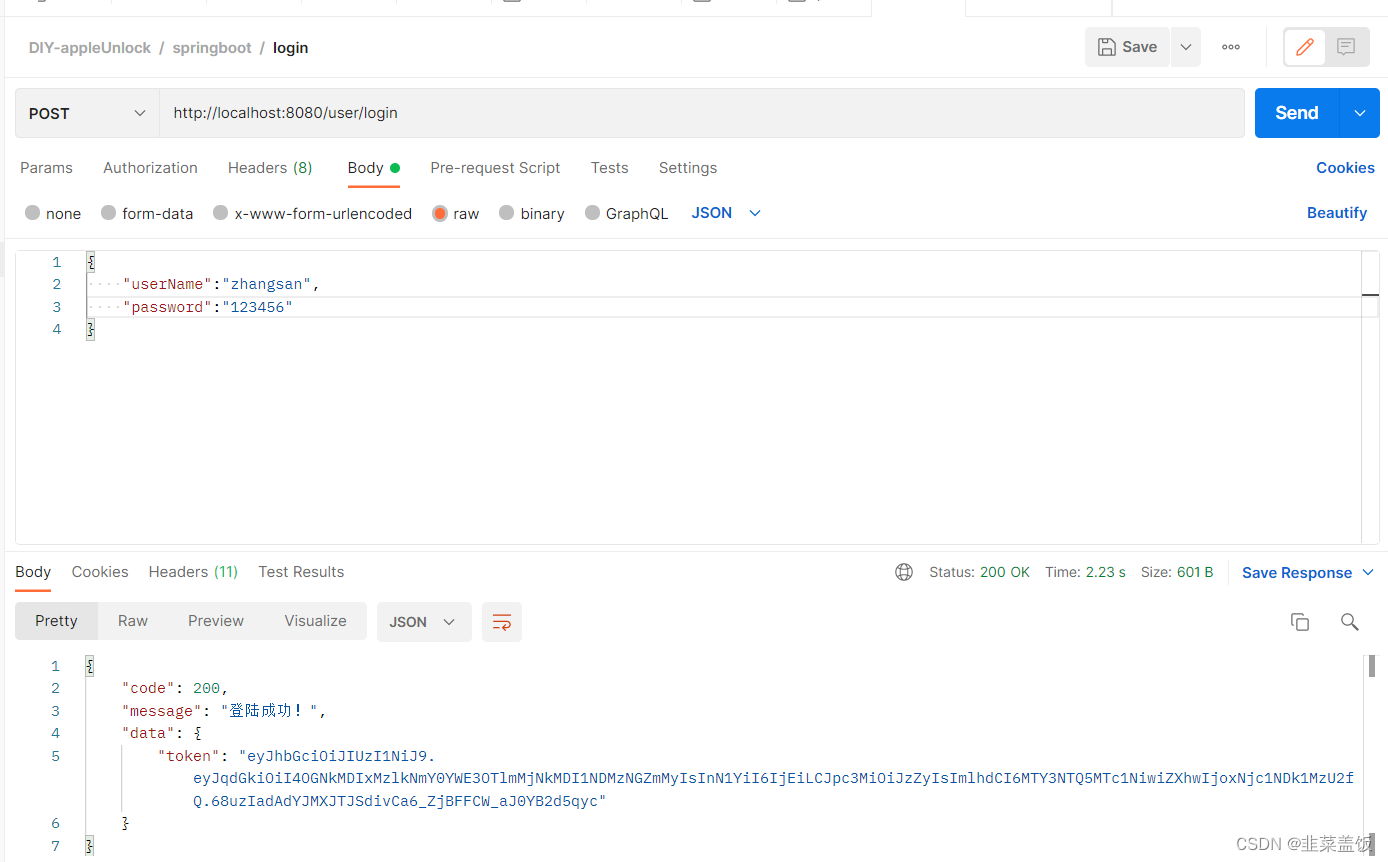Tabla de contenido
Introducción
Securityes un marco de gestión de la seguridad en Springla familia . En comparación con otro marco de seguridad Shiro, proporciona funciones más ricas y más recursos comunitarios que Shiro.
Para obtener una introducción detallada y comenzar, consulte Primeros pasos con springSecurity
Estudio preliminar del principio
Antes de implementarlo, debe comprender el proceso y SpringSecurityel principio de verificación de inicio de sesión y el proceso de autenticación.
1. Proceso de verificación de inicio de sesión

2. El proceso completo de Spring Security
SpringSecurityEl principio es en realidad una cadena de filtros, que contiene filtros que proporcionan varias funciones. Aquí podemos ver el filtro en el ejemplo inicial.

En la figura solo se muestran los filtros centrales y no se muestran otros filtros secundarios.
UsernamePasswordAuthenticationFilter : responsable de procesar la solicitud de inicio de sesión después de que completemos el nombre de usuario y la contraseña en la página de inicio de sesión. Es el principal responsable del trabajo de certificación del caso de entrada.
ExceptionTranslationFilterAccessDeniedException : Maneja cualquier suma lanzada en la cadena de filtros AuthenticationException.
FilterSecurityInterceptor : un filtro responsable de la verificación de permisos.
Podemos comprobar qué filtros están en la cadena de filtros y su orden Debugen el sistema actual .SpringSecurity

3. Proceso de certificación

Comprobación rápida del concepto:
-
AuthenticationInterfaz: su clase de implementación representa al usuario que actualmente accede al sistema y encapsula información relacionada con el usuario. -
AuthenticationManagerInterfaz: define el método de Autenticación Autenticación -
UserDetailsServiceInterfaz: la interfaz central para cargar datos específicos del usuario. Define un método para consultar la información del usuario en función del nombre de usuario. -
UserDetailsInterfaz: proporciona información básica del usuario.UserDetailsServiceLa información de usuario obtenida y procesada por el nombre de usuario debe encapsularse en unUserDetailsobjeto y devolverse. Esta información luego se encapsula enAuthenticationobjetos.
Ideas de implementación
Acceso
①Interfaz de inicio de sesión personalizada
El método para llamar ProviderManagera la autenticación si se pasa la autenticaciónjwt
Almacenar la información del usuario redisen
② PersonalizaciónUserDetailsService
En esta clase de implementación para consultar la base de datos
controlar:
① Definir el filtro de autenticación Jwt
conseguirtoken
Analizar tokeny obtener eluserid
redisObtener información del usuario de
depósitoSecurityContextHolder
Aquí implementamos principalmente la función de la interfaz de inicio de sesión.
La idea central es reescribir su método 认证流程para que consulte datos de la base de datos, y luego implementarlo con nuestra propia clase (Estoy aquí ) , y regresarUserDetailsServiceloadUserByUsernameUserLoginUserDetailsloadUserByUsernameUserLogin
Implementación de la interfaz de inicio de sesión
Preparación
Agregar dependencias, agregar clases de herramientas, crear bases de datos, escribir archivos de configuración
1. Agregar dependencias
<!--redis依赖-->
<dependency>
<groupId>org.springframework.boot</groupId>
<artifactId>spring-boot-starter-data-redis</artifactId>
</dependency>
<!--fastjson依赖-->
<dependency>
<groupId>com.alibaba</groupId>
<artifactId>fastjson</artifactId>
<version>1.2.33</version>
</dependency>
<!--jwt依赖-->
<dependency>
<groupId>io.jsonwebtoken</groupId>
<artifactId>jjwt</artifactId>
<version>0.9.0</version>
</dependency>
<dependency>
<groupId>com.baomidou</groupId>
<artifactId>mybatis-plus-boot-starter</artifactId>
<version>3.4.3</version>
</dependency>
<dependency>
<groupId>mysql</groupId>
<artifactId>mysql-connector-java</artifactId>
</dependency>
2. Agregue la configuración relacionada con Redis
import com.alibaba.fastjson.JSON;
import com.alibaba.fastjson.serializer.SerializerFeature;
import com.fasterxml.jackson.databind.JavaType;
import com.fasterxml.jackson.databind.ObjectMapper;
import com.fasterxml.jackson.databind.type.TypeFactory;
import org.springframework.data.redis.serializer.RedisSerializer;
import org.springframework.data.redis.serializer.SerializationException;
import com.alibaba.fastjson.parser.ParserConfig;
import org.springframework.util.Assert;
import java.nio.charset.Charset;
/**
* Redis使用FastJson序列化
*
* @author sg
*/
public class FastJsonRedisSerializer<T> implements RedisSerializer<T>
{
public static final Charset DEFAULT_CHARSET = Charset.forName("UTF-8");
private Class<T> clazz;
static
{
ParserConfig.getGlobalInstance().setAutoTypeSupport(true);
}
public FastJsonRedisSerializer(Class<T> clazz)
{
super();
this.clazz = clazz;
}
@Override
public byte[] serialize(T t) throws SerializationException
{
if (t == null)
{
return new byte[0];
}
return JSON.toJSONString(t, SerializerFeature.WriteClassName).getBytes(DEFAULT_CHARSET);
}
@Override
public T deserialize(byte[] bytes) throws SerializationException
{
if (bytes == null || bytes.length <= 0)
{
return null;
}
String str = new String(bytes, DEFAULT_CHARSET);
return JSON.parseObject(str, clazz);
}
protected JavaType getJavaType(Class<?> clazz)
{
return TypeFactory.defaultInstance().constructType(clazz);
}
}
import org.springframework.context.annotation.Bean;
import org.springframework.context.annotation.Configuration;
import org.springframework.data.redis.connection.RedisConnectionFactory;
import org.springframework.data.redis.core.RedisTemplate;
import org.springframework.data.redis.serializer.StringRedisSerializer;
@Configuration
public class RedisConfig {
@Bean
@SuppressWarnings(value = {
"unchecked", "rawtypes" })
public RedisTemplate<Object, Object> redisTemplate(RedisConnectionFactory connectionFactory)
{
RedisTemplate<Object, Object> template = new RedisTemplate<>();
template.setConnectionFactory(connectionFactory);
FastJsonRedisSerializer serializer = new FastJsonRedisSerializer(Object.class);
// 使用StringRedisSerializer来序列化和反序列化redis的key值
template.setKeySerializer(new StringRedisSerializer());
template.setValueSerializer(serializer);
// Hash的key也采用StringRedisSerializer的序列化方式
template.setHashKeySerializer(new StringRedisSerializer());
template.setHashValueSerializer(serializer);
template.afterPropertiesSet();
return template;
}
}
Encapsular los datos devueltos
import com.fasterxml.jackson.annotation.JsonInclude;
@JsonInclude(JsonInclude.Include.NON_NULL)
public class ResponseResult<T> {
/**
* 状态码
*/
private Integer code;
/**
* 提示信息,如果有错误时,前端可以获取该字段进行提示
*/
private String msg;
/**
* 查询到的结果数据,
*/
private T data;
public ResponseResult(Integer code, String msg) {
this.code = code;
this.msg = msg;
}
public ResponseResult(Integer code, T data) {
this.code = code;
this.data = data;
}
public Integer getCode() {
return code;
}
public void setCode(Integer code) {
this.code = code;
}
public String getMsg() {
return msg;
}
public void setMsg(String msg) {
this.msg = msg;
}
public T getData() {
return data;
}
public void setData(T data) {
this.data = data;
}
public ResponseResult(Integer code, String msg, T data) {
this.code = code;
this.msg = msg;
this.data = data;
}
}
Clase de herramienta JWT
import io.jsonwebtoken.Claims;
import io.jsonwebtoken.JwtBuilder;
import io.jsonwebtoken.Jwts;
import io.jsonwebtoken.SignatureAlgorithm;
import javax.crypto.SecretKey;
import javax.crypto.spec.SecretKeySpec;
import java.util.Base64;
import java.util.Date;
import java.util.UUID;
/**
* JWT工具类
*/
public class JwtUtil {
//有效期为
public static final Long JWT_TTL = 60 * 60 *1000L;// 60 * 60 *1000 一个小时
//设置秘钥明文
public static final String JWT_KEY = "sangeng";
public static String getUUID(){
String token = UUID.randomUUID().toString().replaceAll("-", "");
return token;
}
/**
* 生成jtw
* @param subject token中要存放的数据(json格式)
* @return
*/
public static String createJWT(String subject) {
JwtBuilder builder = getJwtBuilder(subject, null, getUUID());// 设置过期时间
return builder.compact();
}
/**
* 生成jtw
* @param subject token中要存放的数据(json格式)
* @param ttlMillis token超时时间
* @return
*/
public static String createJWT(String subject, Long ttlMillis) {
JwtBuilder builder = getJwtBuilder(subject, ttlMillis, getUUID());// 设置过期时间
return builder.compact();
}
private static JwtBuilder getJwtBuilder(String subject, Long ttlMillis, String uuid) {
SignatureAlgorithm signatureAlgorithm = SignatureAlgorithm.HS256;
SecretKey secretKey = generalKey();
long nowMillis = System.currentTimeMillis();
Date now = new Date(nowMillis);
if(ttlMillis==null){
ttlMillis=JwtUtil.JWT_TTL;
}
long expMillis = nowMillis + ttlMillis;
Date expDate = new Date(expMillis);
return Jwts.builder()
.setId(uuid) //唯一的ID
.setSubject(subject) // 主题 可以是JSON数据
.setIssuer("sg") // 签发者
.setIssuedAt(now) // 签发时间
.signWith(signatureAlgorithm, secretKey) //使用HS256对称加密算法签名, 第二个参数为秘钥
.setExpiration(expDate);
}
/**
* 创建token
* @param id
* @param subject
* @param ttlMillis
* @return
*/
public static String createJWT(String id, String subject, Long ttlMillis) {
JwtBuilder builder = getJwtBuilder(subject, ttlMillis, id);// 设置过期时间
return builder.compact();
}
public static void main(String[] args) throws Exception {
String token = "eyJhbGciOiJIUzI1NiJ9.eyJqdGkiOiJjYWM2ZDVhZi1mNjVlLTQ0MDAtYjcxMi0zYWEwOGIyOTIwYjQiLCJzdWIiOiJzZyIsImlzcyI6InNnIiwiaWF0IjoxNjM4MTA2NzEyLCJleHAiOjE2MzgxMTAzMTJ9.JVsSbkP94wuczb4QryQbAke3ysBDIL5ou8fWsbt_ebg";
Claims claims = parseJWT(token);
System.out.println(claims);
}
/**
* 生成加密后的秘钥 secretKey
* @return
*/
public static SecretKey generalKey() {
byte[] encodedKey = Base64.getDecoder().decode(JwtUtil.JWT_KEY);
SecretKey key = new SecretKeySpec(encodedKey, 0, encodedKey.length, "AES");
return key;
}
/**
* 解析
*
* @param jwt
* @return
* @throws Exception
*/
public static Claims parseJWT(String jwt) throws Exception {
SecretKey secretKey = generalKey();
return Jwts.parser()
.setSigningKey(secretKey)
.parseClaimsJws(jwt)
.getBody();
}
}
Clase de herramienta Redis
import java.util.*;
import java.util.concurrent.TimeUnit;
@SuppressWarnings(value = {
"unchecked", "rawtypes" })
@Component
public class RedisCache
{
@Autowired
public RedisTemplate redisTemplate;
/**
* 缓存基本的对象,Integer、String、实体类等
*
* @param key 缓存的键值
* @param value 缓存的值
*/
public <T> void setCacheObject(final String key, final T value)
{
redisTemplate.opsForValue().set(key, value);
}
/**
* 缓存基本的对象,Integer、String、实体类等
*
* @param key 缓存的键值
* @param value 缓存的值
* @param timeout 时间
* @param timeUnit 时间颗粒度
*/
public <T> void setCacheObject(final String key, final T value, final Integer timeout, final TimeUnit timeUnit)
{
redisTemplate.opsForValue().set(key, value, timeout, timeUnit);
}
/**
* 设置有效时间
*
* @param key Redis键
* @param timeout 超时时间
* @return true=设置成功;false=设置失败
*/
public boolean expire(final String key, final long timeout)
{
return expire(key, timeout, TimeUnit.SECONDS);
}
/**
* 设置有效时间
*
* @param key Redis键
* @param timeout 超时时间
* @param unit 时间单位
* @return true=设置成功;false=设置失败
*/
public boolean expire(final String key, final long timeout, final TimeUnit unit)
{
return redisTemplate.expire(key, timeout, unit);
}
/**
* 获得缓存的基本对象。
*
* @param key 缓存键值
* @return 缓存键值对应的数据
*/
public <T> T getCacheObject(final String key)
{
ValueOperations<String, T> operation = redisTemplate.opsForValue();
return operation.get(key);
}
/**
* 删除单个对象
*
* @param key
*/
public boolean deleteObject(final String key)
{
return redisTemplate.delete(key);
}
/**
* 删除集合对象
*
* @param collection 多个对象
* @return
*/
public long deleteObject(final Collection collection)
{
return redisTemplate.delete(collection);
}
/**
* 缓存List数据
*
* @param key 缓存的键值
* @param dataList 待缓存的List数据
* @return 缓存的对象
*/
public <T> long setCacheList(final String key, final List<T> dataList)
{
Long count = redisTemplate.opsForList().rightPushAll(key, dataList);
return count == null ? 0 : count;
}
/**
* 获得缓存的list对象
*
* @param key 缓存的键值
* @return 缓存键值对应的数据
*/
public <T> List<T> getCacheList(final String key)
{
return redisTemplate.opsForList().range(key, 0, -1);
}
/**
* 缓存Set
*
* @param key 缓存键值
* @param dataSet 缓存的数据
* @return 缓存数据的对象
*/
public <T> BoundSetOperations<String, T> setCacheSet(final String key, final Set<T> dataSet)
{
BoundSetOperations<String, T> setOperation = redisTemplate.boundSetOps(key);
Iterator<T> it = dataSet.iterator();
while (it.hasNext())
{
setOperation.add(it.next());
}
return setOperation;
}
/**
* 获得缓存的set
*
* @param key
* @return
*/
public <T> Set<T> getCacheSet(final String key)
{
return redisTemplate.opsForSet().members(key);
}
/**
* 缓存Map
*
* @param key
* @param dataMap
*/
public <T> void setCacheMap(final String key, final Map<String, T> dataMap)
{
if (dataMap != null) {
redisTemplate.opsForHash().putAll(key, dataMap);
}
}
/**
* 获得缓存的Map
*
* @param key
* @return
*/
public <T> Map<String, T> getCacheMap(final String key)
{
return redisTemplate.opsForHash().entries(key);
}
/**
* 往Hash中存入数据
*
* @param key Redis键
* @param hKey Hash键
* @param value 值
*/
public <T> void setCacheMapValue(final String key, final String hKey, final T value)
{
redisTemplate.opsForHash().put(key, hKey, value);
}
/**
* 获取Hash中的数据
*
* @param key Redis键
* @param hKey Hash键
* @return Hash中的对象
*/
public <T> T getCacheMapValue(final String key, final String hKey)
{
HashOperations<String, String, T> opsForHash = redisTemplate.opsForHash();
return opsForHash.get(key, hKey);
}
/**
* 删除Hash中的数据
*
* @param key
* @param hkey
*/
public void delCacheMapValue(final String key, final String hkey)
{
HashOperations hashOperations = redisTemplate.opsForHash();
hashOperations.delete(key, hkey);
}
/**
* 获取多个Hash中的数据
*
* @param key Redis键
* @param hKeys Hash键集合
* @return Hash对象集合
*/
public <T> List<T> getMultiCacheMapValue(final String key, final Collection<Object> hKeys)
{
return redisTemplate.opsForHash().multiGet(key, hKeys);
}
/**
* 获得缓存的基本对象列表
*
* @param pattern 字符串前缀
* @return 对象列表
*/
public Collection<String> keys(final String pattern)
{
return redisTemplate.keys(pattern);
}
}
Renderizar cadena a la clase de utilidad del cliente
import javax.servlet.http.HttpServletResponse;
import java.io.IOException;
public class WebUtils
{
/**
* 将字符串渲染到客户端
*
* @param response 渲染对象
* @param string 待渲染的字符串
* @return null
*/
public static String renderString(HttpServletResponse response, String string) {
try
{
response.setStatus(200);
response.setContentType("application/json");
response.setCharacterEncoding("utf-8");
response.getWriter().print(string);
}
catch (IOException e)
{
e.printStackTrace();
}
return null;
}
}
Sentencia SQL para crear una tabla de usuario
CREATE TABLE `sys_user` (
`id` BIGINT(20) NOT NULL AUTO_INCREMENT COMMENT '主键',
`user_name` VARCHAR(64) NOT NULL DEFAULT 'NULL' COMMENT '用户名',
`nick_name` VARCHAR(64) NOT NULL DEFAULT 'NULL' COMMENT '昵称',
`password` VARCHAR(64) NOT NULL DEFAULT 'NULL' COMMENT '密码',
`status` CHAR(1) DEFAULT '0' COMMENT '账号状态(0正常 1停用)',
`email` VARCHAR(64) DEFAULT NULL COMMENT '邮箱',
`phonenumber` VARCHAR(32) DEFAULT NULL COMMENT '手机号',
`sex` CHAR(1) DEFAULT NULL COMMENT '用户性别(0男,1女,2未知)',
`avatar` VARCHAR(128) DEFAULT NULL COMMENT '头像',
`user_type` CHAR(1) NOT NULL DEFAULT '1' COMMENT '用户类型(0管理员,1普通用户)',
`create_by` BIGINT(20) DEFAULT NULL COMMENT '创建人的用户id',
`create_time` DATETIME DEFAULT NULL COMMENT '创建时间',
`update_by` BIGINT(20) DEFAULT NULL COMMENT '更新人',
`update_time` DATETIME DEFAULT NULL COMMENT '更新时间',
`del_flag` INT(11) DEFAULT '0' COMMENT '删除标志(0代表未删除,1代表已删除)',
PRIMARY KEY (`id`)
) ENGINE=INNODB AUTO_INCREMENT=2 DEFAULT CHARSET=utf8mb4 COMMENT='用户表'
archivo de configuración
spring:
datasource:
driver-class-name: com.mysql.cj.jdbc.Driver
url: jdbc:mysql://localhost:3306/你的数据库名称?serverTimezone=GMT%2B8&useUnicode=true&characterEncoding=UTF-8
username: ****
password: ****
redis:
# Redis服务器地址
host: 127.0.0.1
# Redis服务器连接端口
port: 6379
# Redis服务器连接密码
password:
# Redis数据库索引
database: 3
# 连接超时时间(毫秒)
timeout: 30000
lettuce:
pool:
max-active: 50
max-wait: -1
max-idle: 50
min-idle: 1
Implementación de codificación
Estructura de directorios
Acerca Emailde la clase no me importa

Clase de configuración Clase
RedisConfig
package com.zzuli.common.config;
import com.zzuli.common.utils.FastJsonRedisSerializer;
import org.springframework.data.redis.connection.RedisConnectionFactory;
import org.springframework.data.redis.core.RedisTemplate;
import org.springframework.data.redis.serializer.StringRedisSerializer;
public class RedisConfig {
public RedisTemplate<Object, Object> redisTemplate(RedisConnectionFactory connectionFactory)
{
RedisTemplate<Object, Object> template = new RedisTemplate<>();
template.setConnectionFactory(connectionFactory);
FastJsonRedisSerializer serializer = new FastJsonRedisSerializer(Object.class);
// 使用StringRedisSerializer来序列化和反序列化redis的key值
template.setKeySerializer(new StringRedisSerializer());
template.setValueSerializer(serializer);
// Hash的key也采用StringRedisSerializer的序列化方式
template.setHashKeySerializer(new StringRedisSerializer());
template.setHashValueSerializer(serializer);
template.afterPropertiesSet();
return template;
}
}
SecurityConfigamable
package com.zzuli.common.config;
import org.springframework.context.annotation.Bean;
import org.springframework.context.annotation.Configuration;
import org.springframework.security.authentication.AuthenticationManager;
import org.springframework.security.config.annotation.web.builders.HttpSecurity;
import org.springframework.security.config.annotation.web.configuration.WebSecurityConfigurerAdapter;
import org.springframework.security.config.http.SessionCreationPolicy;
import org.springframework.security.crypto.bcrypt.BCryptPasswordEncoder;
import org.springframework.security.crypto.password.PasswordEncoder;
/**
* @author niuben
*/
@Configuration
public class SecurityConfig extends WebSecurityConfigurerAdapter {
//创建BCryptPasswordEncoder注入容器
@Bean
public PasswordEncoder passwordEncoder(){
return new BCryptPasswordEncoder();
}
@Override
protected void configure(HttpSecurity http) throws Exception {
http
//关闭csrf
.csrf().disable()
//不通过Session获取SecurityContext
.sessionManagement().sessionCreationPolicy(SessionCreationPolicy.STATELESS)
.and()
.authorizeRequests()
// 对于登录接口 允许匿名访问
.antMatchers("/user/login").anonymous()
// 除上面外的所有请求全部需要鉴权认证
.anyRequest().authenticated();
}
@Bean
@Override
public AuthenticationManager authenticationManagerBean() throws Exception {
return super.authenticationManagerBean();
}
}
clase de entidad
User类
package com.zzuli.pojo;
import com.baomidou.mybatisplus.annotation.TableId;
import com.baomidou.mybatisplus.annotation.TableName;
import lombok.AllArgsConstructor;
import lombok.Data;
import lombok.NoArgsConstructor;
import java.io.Serializable;
import java.util.Date;
/**
* 用户表(User)实体类
*
* @author 三更
*/
@Data
@AllArgsConstructor
@NoArgsConstructor
@TableName("sys_user") //数据库的用户名名称
public class User implements Serializable {
private static final long serialVersionUID = -40356785423868312L;
/**
* 主键
*/
@TableId
private Long id;
/**
* 用户名
*/
private String userName;
/**
* 昵称
*/
private String nickName;
/**
* 密码
*/
private String password;
/**
* 账号状态(0正常 1停用)
*/
private String status;
/**
* 邮箱
*/
private String email;
/**
* 手机号
*/
private String phonenumber;
/**
* 用户性别(0男,1女,2未知)
*/
private String sex;
/**
* 头像
*/
private String avatar;
/**
* 用户类型(0管理员,1普通用户)
*/
private String userType;
/**
* 创建人的用户id
*/
private Long createBy;
/**
* 创建时间
*/
private Date createTime;
/**
* 更新人
*/
private Long updateBy;
/**
* 更新时间
*/
private Date updateTime;
/**
* 删除标志(0代表未删除,1代表已删除)
*/
private Integer delFlag;
}
UserLogin
herencia de claseUserDetails
package com.zzuli.pojo;
import lombok.AllArgsConstructor;
import lombok.Data;
import lombok.NoArgsConstructor;
import org.springframework.security.core.GrantedAuthority;
import org.springframework.security.core.userdetails.UserDetails;
import java.util.Collection;
/**
* @author niuben
*/
@AllArgsConstructor
@NoArgsConstructor
@Data
public class UserLogin implements UserDetails {
private User user;
@Override
public Collection<? extends GrantedAuthority> getAuthorities() {
return null;
}
@Override
public String getPassword() {
return user.getPassword();
}
@Override
public String getUsername() {
return user.getUserName();
}
@Override
public boolean isAccountNonExpired() {
return true;
}
@Override
public boolean isAccountNonLocked() {
return true;
}
@Override
public boolean isCredentialsNonExpired() {
return true;
}
@Override
public boolean isEnabled() {
return true;
}
}
interfaz implementa
LoginControllerinterfaz de clase
package com.zzuli.controller;
import com.zzuli.common.api.CommonResult;
import com.zzuli.pojo.User;
import com.zzuli.service.LoginService;
import org.springframework.web.bind.annotation.PostMapping;
import org.springframework.web.bind.annotation.RequestBody;
import org.springframework.web.bind.annotation.RequestMapping;
import org.springframework.web.bind.annotation.RestController;
import javax.annotation.Resource;
/**
* @author niuben
*/
@RestController
public class LoginController {
@Resource
private LoginService loginService;
@PostMapping("/user/login")
public CommonResult<Object> login(@RequestBody User user){
CommonResult<Object> result = null;
try {
result = loginService.login(user);
} catch (Exception e) {
return CommonResult.success("账户或者密码错误!");
}
return result;
}
}
UserDetailsServiceImplClase de implementación
package com.zzuli.service.impl;
import com.baomidou.mybatisplus.core.conditions.query.LambdaQueryWrapper;
import com.zzuli.mapper.UserMapper;
import com.zzuli.pojo.User;
import com.zzuli.pojo.UserLogin;
import org.springframework.security.core.userdetails.UserDetails;
import org.springframework.security.core.userdetails.UserDetailsService;
import org.springframework.security.core.userdetails.UsernameNotFoundException;
import org.springframework.stereotype.Service;
import javax.annotation.Resource;
import java.util.Objects;
/**
* @author niuben
*/
@Service
public class UserDetailsServiceImpl implements UserDetailsService {
@Resource
private UserMapper userMapper;
@Override
public UserDetails loadUserByUsername(String username) throws UsernameNotFoundException {
//查询用户信息
LambdaQueryWrapper<User> queryWrapper = new LambdaQueryWrapper<User>();
queryWrapper.eq(User::getUserName,username);
User user = userMapper.selectOne(queryWrapper);
//如果没有查询到用户,就抛出异常
if(Objects.isNull(user)){
throw new RuntimeException("用户名或者密码错误!");
}
//将数据封装成UserDetails
return new UserLogin(user);
}
}
LoginServiceinterfaz
package com.zzuli.service;
import com.zzuli.common.api.CommonResult;
import com.zzuli.pojo.User;
/**
* @author niuben
*/
public interface LoginService {
CommonResult<Object> login(User user);
}
LoginServiceimplementar la interfaz
package com.zzuli.service.impl;
import com.zzuli.common.api.CommonResult;
import com.zzuli.common.utils.JwtUtil;
import com.zzuli.common.utils.RedisCache;
import com.zzuli.pojo.User;
import com.zzuli.pojo.UserLogin;
import com.zzuli.service.LoginService;
import org.springframework.security.authentication.AuthenticationManager;
import org.springframework.security.authentication.UsernamePasswordAuthenticationToken;
import org.springframework.security.core.Authentication;
import org.springframework.stereotype.Service;
import javax.annotation.Resource;
import java.util.HashMap;
import java.util.Map;
import java.util.Objects;
/**
* @author niuben
*/
@Service
public class LoginServiceImpl implements LoginService {
@Resource
private AuthenticationManager authenticationManager;
@Resource
private RedisCache redisCache;
@Override
public CommonResult<Object> login(User user) {
//进行用户认证
UsernamePasswordAuthenticationToken authenticationToken =
new UsernamePasswordAuthenticationToken(user.getUserName(),user.getPassword());
Authentication authenticate = authenticationManager.authenticate(authenticationToken);
//认证未通过,给出提示
if(Objects.isNull(authenticate)){
throw new RuntimeException("登陆失败!");
}
//通过了,生成jwt
UserLogin loginUser = (UserLogin) authenticate.getPrincipal();
String id = loginUser.getUser().getId().toString();
String jwt = JwtUtil.createJWT(id);
Map<String,String> map = new HashMap<>();
map.put("token",jwt);
//将用户信息存入redis
redisCache.setCacheObject("login"+id,loginUser);
return CommonResult.success(map,"登陆成功!");
}
}
UserMapperamable
package com.zzuli.mapper;
import com.baomidou.mybatisplus.core.mapper.BaseMapper;
import com.zzuli.pojo.User;
public interface UserMapper extends BaseMapper<User> {
}
clase de inicio
package com.zzuli;
import org.apache.ibatis.annotations.Mapper;
import org.mybatis.spring.annotation.MapperScan;
import org.springframework.boot.SpringApplication;
import org.springframework.boot.autoconfigure.SpringBootApplication;
@SpringBootApplication
@MapperScan("com.zzuli.mapper") //mapper扫描器
public class AppleunlockManageApplication {
public static void main(String[] args) {
SpringApplication.run(AppleunlockManageApplication.class, args);
}
}
Mostrar resultados
Nota: Para abrir durante la prueba redis, la contraseña en la base de datos debe estar encriptada.
Puede usar el siguiente método para encriptar, passwordEncoderque SecurityConfigse ha inyectado en
@Resource
private PasswordEncoder passwordEncoder;
String encode = passwordEncoder.encode("123456");
System.out.println(encode);

Prueba de interfaz de inicio de sesión
